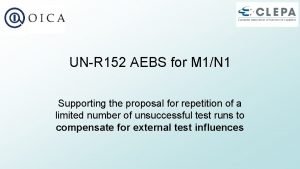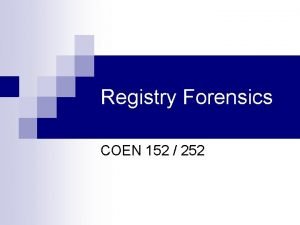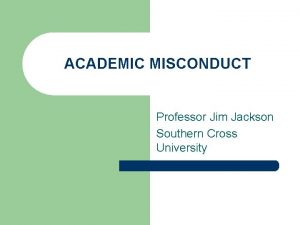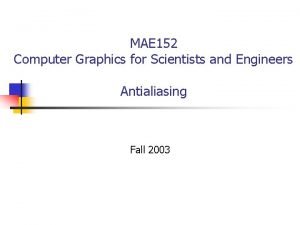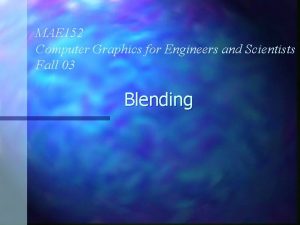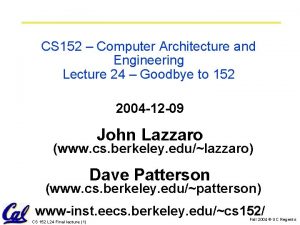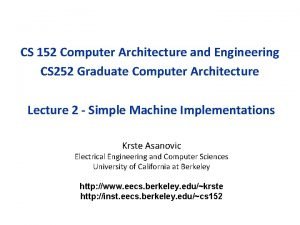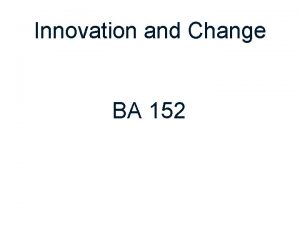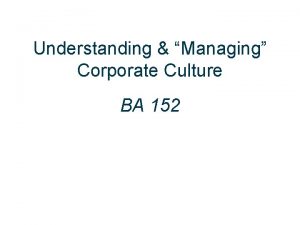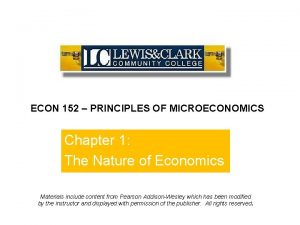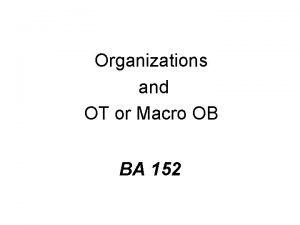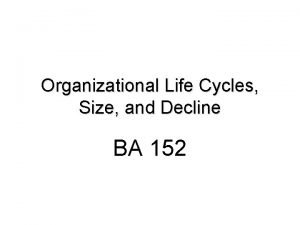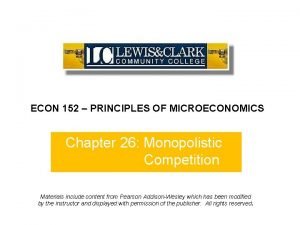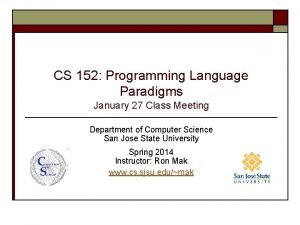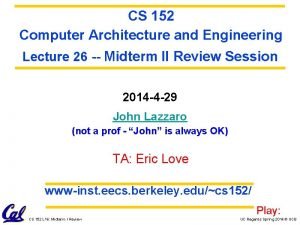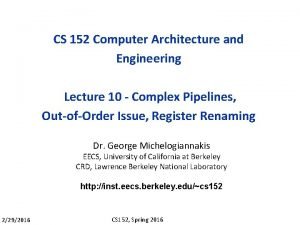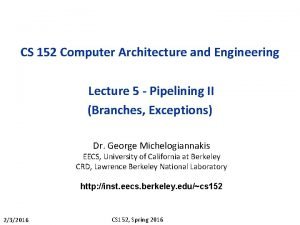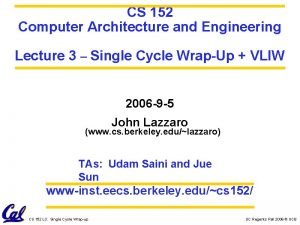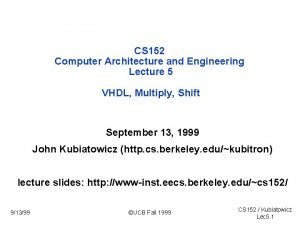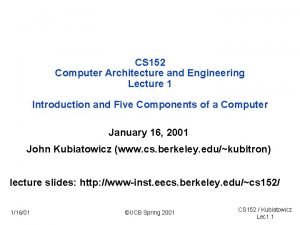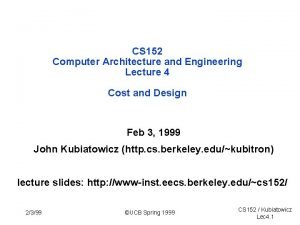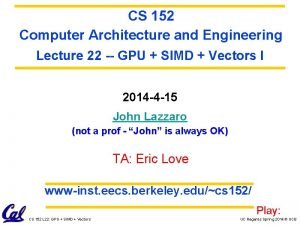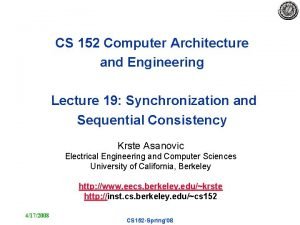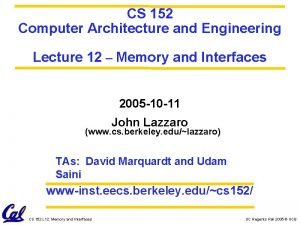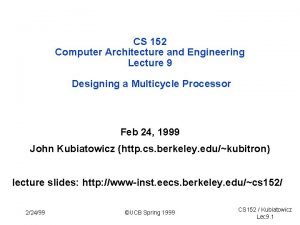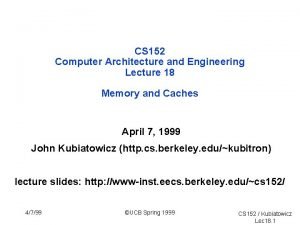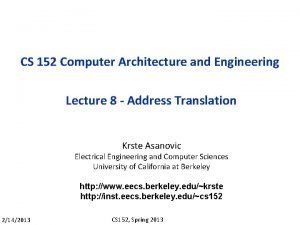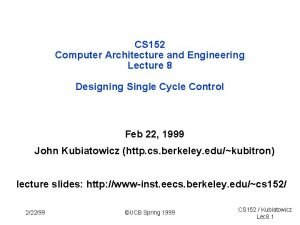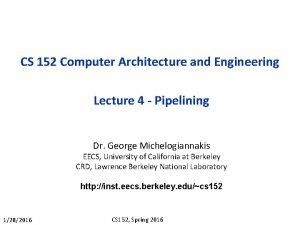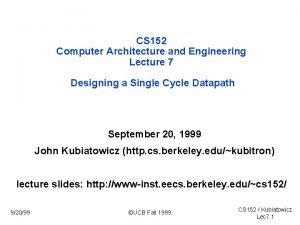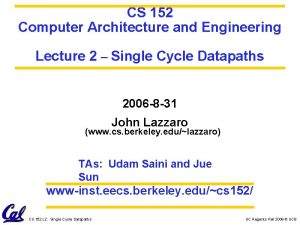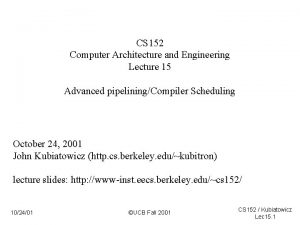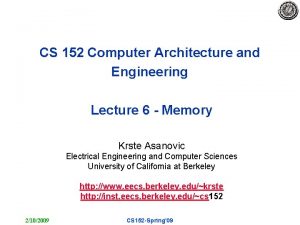CS 152 Computer Architecture and Engineering Lecture 22


















![6. Reducing Misses by Compiler Optimizations ° Mc. Farling [1989] reduced caches misses by 6. Reducing Misses by Compiler Optimizations ° Mc. Farling [1989] reduced caches misses by](https://slidetodoc.com/presentation_image/1155eaba6e7d2a4798de86ddaed0be8c/image-19.jpg)















- Slides: 34

CS 152 Computer Architecture and Engineering Lecture 22 Advanced Caching April 23, 2003 John Kubiatowicz (www. cs. berkeley. edu/~kubitron) lecture slides: http: //inst. eecs. berkeley. edu/~cs 152/ 4/23/03 ©UCB Spring 2003 CS 152 / Kubiatowicz Lec 22. 1

Recap: Set Associative Cache ° N way set associative: N entries for each Cache Index • N direct mapped caches operates in parallel ° Example: Two way set associative cache • Cache Index selects a “set” from the cache • The two tags in the set are compared to the input in parallel • Data is selected based on the tag result Valid Cache Tag : : Adr Tag Compare Cache Index Cache Data Cache Block 0 : : Sel 1 1 Mux 0 Sel 0 Cache Tag Valid : : Compare OR Hit 4/23/03 Cache Block ©UCB Spring 2003 CS 152 / Kubiatowicz Lec 22. 2

Recap: Cache Performance Execution_Time = Instruction_Count x Cycle_Time x (ideal CPI + Memory_Stalls/Inst + Other_Stalls/Inst) Memory_Stalls/Inst = Instruction Miss Rate x Instruction Miss Penalty + Loads/Inst x Load Miss Rate x Load Miss Penalty + Stores/Inst x Store Miss Rate x Store Miss Penalty Average Memory Access time (AMAT) = Hit Time. L 1 + (Miss Rate. L 1 x Miss Penalty. L 1) = (Hit Rate. L 1 x Hit Time. L 1) + (Miss Rate. L 1 x Miss Time. L 1) 4/23/03 ©UCB Spring 2003 CS 152 / Kubiatowicz Lec 22. 3

Recap: A Summary on Sources of Cache Misses ° Compulsory (cold start or process migration, first reference): first access to a block • “Cold” fact of life: not a whole lot you can do about it • Note: If you are going to run “billions” of instruction, Compulsory Misses are insignificant ° Conflict (collision): • Multiple memory locations mapped to the same cache location • Solution 1: increase cache size • Solution 2: increase associativity ° Capacity: • Cache cannot contain all blocks access by the program • Solution: increase cache size ° Coherence (Invalidation): other process (e. g. , I/O) updates memory 4/23/03 ©UCB Spring 2003 CS 152 / Kubiatowicz Lec 22. 4

The Big Picture: Where are We Now? ° The Five Classic Components of a Computer Processor Input Control Memory Datapath Output ° Today’s Topics: • • • 4/23/03 Recap last lecture Virtual Memory Protection TLB Buses ©UCB Spring 2003 CS 152 / Kubiatowicz Lec 22. 5

How Do you Design a Memory System? ° Set of Operations that must be supported • read: data <= Mem[Physical Address] • write: Mem[Physical Address] <= Data Physical Address Read/Write Memory “Black Box” Inside it has: Tag Data Storage, Muxes, Comparators, . . . Data ° Determine the internal register transfers ° Design the Datapath ° Design the Cache Controller Address Control Cache Points Cache Data. Path Controller Data In Data Out 4/23/03 ©UCB Spring 2003 Signals R/W Active wait CS 152 / Kubiatowicz Lec 22. 6

Impact on Cycle Time PC Cache Hit Time: directly tied to clock rate increases with cache size increases with associativity I Cache miss IR IRex A B invalid Average Memory Access time = Hit Time + Miss Rate x Miss Penalty Time = IC x CT x (ideal CPI + memory stalls) 4/23/03 ©UCB Spring 2003 IRm R D Cache IRwb T Miss CS 152 / Kubiatowicz Lec 22. 7

Improving Cache Performance: 3 general options Average Memory Access time = Hit Time + (Miss Rate x Miss Penalty) = (Hit Rate x Hit Time) + (Miss Rate x Miss Time) Options to reduce AMAT: 1. Reduce the miss rate, 2. Reduce the miss penalty, or 3. Reduce the time to hit in the cache. 4/23/03 ©UCB Spring 2003 CS 152 / Kubiatowicz Lec 22. 8

Improving Cache Performance 1. Reduce the miss rate, 2. Reduce the miss penalty, or 3. Reduce the time to hit in the cache. 4/23/03 ©UCB Spring 2003 CS 152 / Kubiatowicz Lec 22. 9

3 Cs Absolute Miss Rate (SPEC 92) Conflict 4/23/03 ©UCB Spring 2003 CS 152 / Kubiatowicz Lec 22. 10

2: 1 Cache Rule miss rate 1 way associative cache size X = miss rate 2 way associative cache size X/2 Conflict 4/23/03 ©UCB Spring 2003 CS 152 / Kubiatowicz Lec 22. 11

3 Cs Relative Miss Rate Conflict 4/23/03 ©UCB Spring 2003 CS 152 / Kubiatowicz Lec 22. 12

1. Reduce Misses via Larger Block Size 4/23/03 ©UCB Spring 2003 CS 152 / Kubiatowicz Lec 22. 13

2. Reduce Misses via Higher Associativity ° 2: 1 Cache Rule: • Miss Rate DM cache size N Miss Rate 2 way cache size N/2 ° Beware: Execution time is only final measure! • Will Clock Cycle time increase? • Hill [1988] suggested hit time for 2 way vs. 1 way external cache +10%, internal + 2% 4/23/03 ©UCB Spring 2003 CS 152 / Kubiatowicz Lec 22. 14

Example: Avg. Memory Access Time vs. Miss Rate ° Assume CCT = 1. 10 for 2 way, 1. 12 for 4 way, 1. 14 for 8 way vs. CCT direct mapped Cache Size Associativity (KB) 1 2 4 8 16 32 64 128 2 way 2. 15 1. 86 1. 67 1. 48 1. 32 1. 24 1. 20 1. 17 1 way 2. 33 1. 98 1. 72 1. 46 1. 29 1. 20 1. 14 1. 10 4 way 2. 07 1. 76 1. 61 1. 47 1. 32 1. 25 1. 21 1. 18 8 way 2. 01 1. 68 1. 53 1. 43 1. 32 1. 27 1. 23 1. 20 (Red means A. M. A. T. not improved by more associativity) 4/23/03 ©UCB Spring 2003 CS 152 / Kubiatowicz Lec 22. 15

3. Reducing Misses via a “Victim Cache” ° How to combine fast hit time of direct mapped yet still avoid conflict misses? ° Add buffer to place data discarded from cache ° Jouppi [1990]: 4 entry victim cache removed 20% to 95% of conflicts for a 4 KB direct mapped data cache ° Used in Alpha, HP machines TAGS DATA Tag and Comparator One Cache line of Data To Next Lower Level In Hierarchy 4/23/03 ©UCB Spring 2003 CS 152 / Kubiatowicz Lec 22. 16

4. Reducing Misses by Hardware Prefetching ° E. g. , Instruction Prefetching • Alpha 21064 fetches 2 blocks on a miss • Extra block placed in “stream buffer” • On miss check stream buffer ° Works with data blocks too: • Jouppi [1990] 1 data stream buffer got 25% misses from 4 KB cache; 4 streams got 43% • Palacharla & Kessler [1994] for scientific programs for 8 streams got 50% to 70% of misses from 2 64 KB, 4 way set associative caches ° Prefetching relies on having extra memory bandwidth that can be used without penalty • Could reduce performance if done indiscriminantly!!! 4/23/03 ©UCB Spring 2003 CS 152 / Kubiatowicz Lec 22. 17

5. Reducing Misses by Software Prefetching Data ° Data Prefetch • Load data into register (HP PA RISC loads) • Cache Prefetch: load into cache (MIPS IV, Power. PC, SPARC v. 9) • Special prefetching instructions cannot cause faults; a form of speculative execution ° Issuing Prefetch Instructions takes time • Is cost of prefetch issues < savings in reduced misses? • Higher superscalar reduces difficulty of issue bandwidth 4/23/03 ©UCB Spring 2003 CS 152 / Kubiatowicz Lec 22. 18
![6 Reducing Misses by Compiler Optimizations Mc Farling 1989 reduced caches misses by 6. Reducing Misses by Compiler Optimizations ° Mc. Farling [1989] reduced caches misses by](https://slidetodoc.com/presentation_image/1155eaba6e7d2a4798de86ddaed0be8c/image-19.jpg)
6. Reducing Misses by Compiler Optimizations ° Mc. Farling [1989] reduced caches misses by 75% on 8 KB direct mapped cache, 4 byte blocks in software ° Instructions • Reorder procedures in memory so as to reduce conflict misses • Profiling to look at conflicts(using tools they developed) ° Data • Merging Arrays: improve spatial locality by single array of compound elements vs. 2 arrays • Loop Interchange: change nesting of loops to access data in order stored in memory • Loop Fusion: Combine 2 independent loops that have same looping and some variables overlap • Blocking: Improve temporal locality by accessing “blocks” of data repeatedly vs. going down whole columns or rows 4/23/03 ©UCB Spring 2003 CS 152 / Kubiatowicz Lec 22. 19

Administrivia ° Second midterm coming up (Monday, May 5 th) Will be 5: 30 8: 30 in 306 Soda Hall. La. Val’s afterwards! • Pipelining - Hazards, branches, forwarding, CPI calculations - (may include something on dynamic scheduling) • Memory Hierarchy (including Caches, TLBs, DRAM) • Simple Power issues • Possibly I/O ° Tomorrow Sections Lab • Give a design review to your TA. • Bring block diagrams, design notes, etc. ° Lab 6 debugging? • Dual Port memories: Not a good idea unless absolutely necessary - Often built as multiple banks of single port RAMs • Fifo queuing to handle clock domains: a good idea 4/23/03 Can actually improve DRAM performance! Multiple clock domains often an issue right around DRAM ©UCB Spring 2003 CS 152 / Kubiatowicz Lec 22. 20

Improving Cache Performance (Continued) 1. Reduce the miss rate, 2. Reduce the miss penalty, or 3. Reduce the time to hit in the cache. 4/23/03 ©UCB Spring 2003 CS 152 / Kubiatowicz Lec 22. 21

0. Reducing Penalty: Faster DRAM / Interface ° New DRAM Technologies • • RAMBUS same initial latency, but much higher bandwidth Synchronous DRAM TMJ RAM (Tunneling magnetic junction RAM) from IBM? ? Merged DRAM/Logic IRAM project here at Berkeley ° Better BUS interfaces • Simple Lab 6 example: add write fifo to DRAM controller Cache can dump to DRAM immediately without waiting for RAS/CAS…. ° CRAY Technique: only use SRAM 4/23/03 ©UCB Spring 2003 CS 152 / Kubiatowicz Lec 22. 22

1. Reducing Penalty: Read Priority over Write on Miss Processor Cache DRAM Write Buffer ° A Write Buffer is needed between the Cache and Memory • Processor: writes data into the cache and the write buffer • Memory controller: write contents of the buffer to memory ° Write buffer is just a FIFO: • Typical number of entries: 4 • Works fine if: Store frequency (w. r. t. time) << 1 / DRAM write cycle • Must handle burst behavior as well! 4/23/03 ©UCB Spring 2003 CS 152 / Kubiatowicz Lec 22. 23

RAW Hazards from Write Buffer! ° Write Buffer Issues: Could introduce RAW Hazard with memory! • Write buffer may contain only copy of valid data Reads to memory may get wrong result if we ignore write buffer ° Solutions: • Simply wait for write buffer to empty before servicing reads: - Might increase read miss penalty (old MIPS 1000 by 50% ) • Check write buffer contents before read (“fully associative”); - If no conflicts, let the memory access continue Else grab data from buffer ° Can Write Buffer help with Write Back? • Read miss replacing dirty block - Copy dirty block to write buffer while starting read to memory 3 8 RAS/ CAS Write DATA RAS/ CAS Read DATA Processor + DRAM 4/23/03 DRAM Proc ©UCB Spring 2003 3 8 RAS/ CAS Read DATA RAS/ CAS Write DATA 8 Read DATA CS 152 / Kubiatowicz Lec 22. 24

2. Reduce Penalty: Early Restart and Critical Word First ° Don’t wait for full block to be loaded before restarting CPU • Early restart—As soon as the requested word of the block arrives, send it to the CPU and let the CPU continue execution • Critical Word First—Request the missed word first from memory and send it to the CPU as soon as it arrives; let the CPU continue execution while filling the rest of the words in the block. Also called wrapped fetch and requested word first ° Generally useful only in large blocks, ° Spatial locality a problem; tend to want next sequential word, so not clear if benefit by early restart block 4/23/03 ©UCB Spring 2003 CS 152 / Kubiatowicz Lec 22. 25

3. Reduce Penalty: Non blocking Caches ° Non-blocking cache or lockup-free cache allow data cache to continue to supply cache hits during a miss • requires F/E bits on registers or out of order execution • requires multi bank memories ° “hit under miss” reduces the effective miss penalty by working during miss vs. ignoring CPU requests ° “hit under multiple miss” or “miss under miss” may further lower the effective miss penalty by overlapping multiple misses • Significantly increases the complexity of the cache controller as there can be multiple outstanding memory accesses • Requires muliple memory banks (otherwise cannot support) • Penium Pro allows 4 outstanding memory misses 4/23/03 ©UCB Spring 2003 CS 152 / Kubiatowicz Lec 22. 26

What happens on a Cache miss? ° For in order pipeline, 2 options: • Freeze pipeline in Mem stage (popular early on: Sparc, R 4000) IF ID IF EX ID Mem stall … stall Mem Wr EX stall … stall Ex Wr • Use Full/Empty bits in registers + MSHR queue - - MSHR = “Miss Status/Handler Registers” (Kroft) Each entry in this queue keeps track of status of outstanding memory requests to one complete memory line. – Per cache-line: keep info about memory address. – For each word: register (if any) that is waiting for result. – Used to “merge” multiple requests to one memory line New load creates MSHR entry and sets destination register to “Empty”. Load is “released” from pipeline. Attempt to use register before result returns causes instruction to block in decode stage. Limited “out of order” execution with respect to loads. Popular with in order superscalar architectures. ° Out of order pipelines already have this functionality built in… (load queues, etc). 4/23/03 ©UCB Spring 2003 CS 152 / Kubiatowicz Lec 22. 27

Value of Hit Under Miss for SPEC 0 >1 1 >2 2 >64 Base “Hit under n Misses” Integer Floating Point ° FP programs on average: Penalty = 0. 68 > 0. 52 > 0. 34 > 0. 26 ° Int programs on average: Penalty = 0. 24 > 0. 20 > 0. 19 ° 8 KB Data Cache, Direct Mapped, 32 B block, 16 cycle miss 4/23/03 ©UCB Spring 2003 CS 152 / Kubiatowicz Lec 22. 28

4. Reduce Penalty: Second Level Cache Proc ° L 2 Equations AMAT = Hit Time. L 1 + Miss Rate. L 1 x Miss Penalty. L 1 Cache Miss Penalty. L 1 = Hit Time. L 2 + Miss Rate. L 2 x Miss Penalty. L 2 Cache AMAT = Hit Time. L 1 + Miss Rate. L 1 x (Hit Time. L 2 + Miss Rate. L 2 x Miss Penalty. L 2) ° Definitions: • Local miss rate— misses in this cache divided by the total number of memory accesses to this cache (Miss rate. L 2) • Global miss rate—misses in this cache divided by the total number of memory accesses generated by the CPU (Miss Rate. L 1 x Miss Rate. L 2) • Global Miss Rate is what matters 4/23/03 ©UCB Spring 2003 CS 152 / Kubiatowicz Lec 22. 29

Reducing Misses: which apply to L 2 Cache? ° Reducing Miss Rate 1. Reduce Misses via Larger Block Size 2. Reduce Conflict Misses via Higher Associativity 3. Reducing Conflict Misses via Victim Cache 4. Reducing Misses by HW Prefetching Instr, Data 5. Reducing Misses by SW Prefetching Data 6. Reducing Capacity/Conf. Misses by Compiler Optimizations 4/23/03 ©UCB Spring 2003 CS 152 / Kubiatowicz Lec 22. 30

L 2 cache block size & A. M. A. T. ° 32 KB L 1, 8 byte path to memory 4/23/03 ©UCB Spring 2003 CS 152 / Kubiatowicz Lec 22. 31

Improving Cache Performance (Continued) 1. Reduce the miss rate, 2. Reduce the miss penalty, or 3. Reduce the time to hit in the cache: Lower Associativity (+victim caching or 2 nd level cache)? Multiple cycle Cache access (e. g. R 4000) Harvard Architecture Careful Virtual Memory Design (rest of lecture!) 4/23/03 ©UCB Spring 2003 CS 152 / Kubiatowicz Lec 22. 32

Example: Harvard Architecture Proc Unified Cache-1 Unified Cache-2 I-Cache-1 Proc D-Cache-1 Unified Cache-2 Harvard Architecture Unified ° Sample Statistics: • 16 KB I&D: Inst miss rate=0. 64%, Data miss rate=6. 47% • 32 KB unified: Aggregate miss rate=1. 99% ° Which is better (ignore L 2 cache)? • Assume 33% loads/store, hit time=1, miss time=50 • Note: data hit has 1 stall for unified cache (only one port) AMATHarvard=(1/1. 33)x(1+0. 64%x 50)+(0. 33/1. 33)x(1+6. 47%x 50) = 2. 05 AMATUnified=(1/1. 33)x(1+1. 99%x 50)+(0. 33/1. 33)X(1+1+1. 99%x 50)= 2. 24 4/23/03 ©UCB Spring 2003 CS 152 / Kubiatowicz Lec 22. 33

Summary: Cache techniques ° Caches, TLBs, Virtual Memory all understood by examining how they deal with 4 questions: 1) Where can block be placed? 2) How is block found? 3) What block is replaced on miss? 4) How are writes handled? ° More cynical version of this: Everything in computer architecture is a cache! ° Techniques people use to improve the miss rate of caches: Technique MR Larger Block Size Higher Associativity Victim Caches Pseudo Associative Caches HW Prefetching of Instr/Data Compiler Controlled Prefetching Compiler Reduce Misses 4/23/03 MP + + + + ©UCB Spring 2003 HT Complexity – 0 – 1 2 2 2 3 0 CS 152 / Kubiatowicz Lec 22. 34
 Architecture lecture notes
Architecture lecture notes Isa definition computer
Isa definition computer 01:640:244 lecture notes - lecture 15: plat, idah, farad
01:640:244 lecture notes - lecture 15: plat, idah, farad Difference computer organization and architecture
Difference computer organization and architecture Bus architecture in computer architecture
Bus architecture in computer architecture System procurement process in software engineering
System procurement process in software engineering Simple computer design
Simple computer design Un r 152
Un r 152 Ntuser.dat file
Ntuser.dat file Przedszkole 152 łódź
Przedszkole 152 łódź Re liveri 2006 qca 152
Re liveri 2006 qca 152 Round to the nearest hundred thousand examples
Round to the nearest hundred thousand examples Mae 152
Mae 152 Blending function in computer graphics
Blending function in computer graphics Cs 152 stanford
Cs 152 stanford Cs 152 berkeley
Cs 152 berkeley Ba 152
Ba 152 Ece 152
Ece 152 Ba 152
Ba 152 Econ 152
Econ 152 Which layer in the osi model covers http, ftp, and rdc?
Which layer in the osi model covers http, ftp, and rdc? Ba 152
Ba 152 Macroob
Macroob Ba 152
Ba 152 Plasa
Plasa Econ 152
Econ 152 Ron mak sjsu
Ron mak sjsu Gfi 152
Gfi 152 Financial engineering notes
Financial engineering notes Software engineering lecture notes
Software engineering lecture notes Foundation engineering lecture notes
Foundation engineering lecture notes Professional ethics in engineering notes
Professional ethics in engineering notes Computer security 161 cryptocurrency lecture
Computer security 161 cryptocurrency lecture Computer aided drug design lecture notes
Computer aided drug design lecture notes Call and return architecture
Call and return architecture







